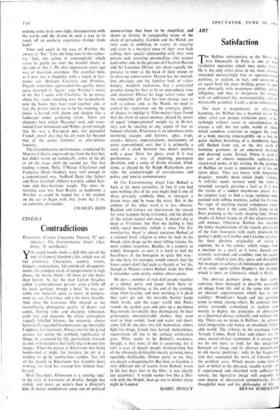ART
Satisfaction
HE Balthus retrospective at the Musce des I Arts Decoratifs in Paris is one of time revelatory occasions which may make history. 'Ile is the only artist alive, in my view, who has remained unswervingly true to representational painting, to realism, in fact, and sustained at an equal level the most thrilling power to com- pose abstractly with maximum subtlety and in. telligence, and thus to invigorate his imagery with an additional life, monumentality, and un- mistakable grandeur. Catch a plane immediately.
The show is magnificent : its after-image haunting, for Balthus has a haunted vision. No other artist can project eroticism quite so dis- turbingly without resort to sensationalism. He creates a still, but not calm, world of silence which somehow contrives to suggest the sound of a body moving imperceptibly on a bed, the quick shallow breathing of a slumbering figure still flushed from sex, or the dry rustle of feminine garments in an otherwise darkened and deserted room. Patrick White is good at this sort of almost impossible realisation in visual-oral terms,. in his writing. In the paintings of Balthus an event is imminent or it has just taken place. They are heavy with languorous disquiet: notably those which imply violence. A still-life seems normal until the knife is revealed, savagely piercing a loaf as if it were the victim of a sudden murderous attack. It is no surprise later to find a large reclining nude, painted with stifling intensity, called La Virtime. No signs of anything except voluptuous excite• ment, but there is the same knife lying on the floor pointing at the rosily sleeping lady. Dismal shades of Julian Green in all this claustrophobia and menace. Otherwise Balthus has recorded the kinky machinations of the strictly private life of the haut bourgeois with steely precision; the painter's debts to Courbet and Cezanne are clear; the final absolute originality of vision is supreme. So is the colour, which ranges from a murmur to a snarl, as it were, though con- sistently restrained and credible; and the quality of paint : which is taut, dry, spare and disciplined but manages to achieve an independent splendour of its own—quite unlike Hopper's, for example, which is inert, or Guttuso's, which is flashy.
The abstract painters alone, in their earlier canvases, have managed to describe accurately an image from life and at the same time erect an abstract superstructure which has its own validity: Mondrian's beach and sky paintings come to mind, among others. By contrast, those artists avowedly committed to realism seem mostly to deploy the principles of abstraction as a theatrical device, cynically and without feel- ing. There are no props in Balthus: he achieves total integration and makes an absolutely believ- able world. The tributes in the catalogue from Artaud, Camus, Rend Char and others arc. for once, matter-of-fact statements. It is strange that we do not have to look for this integration between an image and its abstract presentation in old master paintings: only in the fragmenta- tion that succeeded the work of Cezanne does the problem arise. Which means some kind of lack of belief in the physical, seeable world: for if experienced and absorbed with sufficient in- tensity, the figurative image will engender its own degree of abstraction compulsively, like a thoughtful man and his philosophy, of life.
BRYAN ROBERTSON


































 Previous page
Previous page